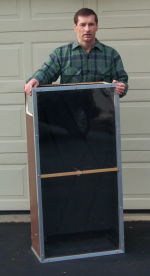Search engine visitors - click here to access entire "$ensible Home" web site
Click here to see a descriptive illustration showing a simple solar window heater.
Dear Jim: I have a room which is chilly. It faces south, but has only one small window for the sun to shine in. Is there any inexpensive simple-to-build solar heater design I can put in the window for more heat? - Sam W.

A: There are several design variations for simple do-it-yourself solar window heaters. I built one for my own home and it produces warm air output at about 120 degrees on a sunny day. I installed an optional ventilation door so it also operates as a free exhaust fan during summer.
I spent about $100 for the materials, but mine is fancy with aluminum trim on all the edges. You should be able to build an efficient one for about $50 in materials or even less if you have some scrap lumber and an old storm door or window around the house. It uses no fans or electricity.
The concept of a solar window heater is simple. It is basically a flat box with two shallow chambers inside, one above the other. The chambers are connected at the outdoor end. One end is mounted in your window opening and sealed with weatherstripping against the sash and the window frame. The other end slopes downward outdoors with a clear top facing the sun's rays.
The sun shines through the clear top into the top chamber and heats the air. This warm air, because it is less dense than cool air, naturally flows up and out into your room. This draws cooler room air into the bottom chamber to create a continuous flow of solar-heated air into your room.
It helps to insulate the warm top chamber from the lower one to increase this air flow (called thermosiphoning) of room air through the heater. It is also critical to insulate the outside surfaces so the room air flowing down the lower chamber does not lose heat to the cold outdoors.
The proper angle to slope the heater depends upon your climate and the dimensions you make it. The further north you live, the steeper it should be because the winter sun is lower in the sky. Once you build it, try different angles to see which warms up your chilly room the most.
Since I live in Cincinnati which gets below zero some days, I built a clear top with two layers of acrylic plastic for better efficiency. I also screwed metal aluminum angle stock (from any hardware store) in the warm chamber to increase heat transfer area and create slight air turbulence.
For free cooling ventilation, install a hinged door in the top of the heater immediately outside the window. During the summer, block the top chamber warm air opening from the heater to your room and open the outdoor hinged door. On a sunny day, the solar-heated air will exhaust out the hinged door and draw air from inside your room for a natural breeze indoors.
Instant Download Update Bulletin No. 442 - do-it-yourself instructions, diagrams (some schematic and some with detailed component dimensions) and materials list for making three differnt designs of solar window heaters, some designs include an optional ventilation door to also cool your house for free during summer.
Dear Jim: I like to work in my garage, but it gets cold during the winter. The rubber strip on the bottom of the garage door does not seal well against the floor. How can I fix this for a better seal? - Ronnie F.
A: That bad seal not only makes your attached garage cold, but it also draws heat through the adjacent house walls. This can make the adjacent rooms feel cold and can increase your heating bills.
First, try to readjust the stop switch on the garage door so it closes further. The seals on the door bottom are usually thick and flexible. You may also purchase a new door seal. They are easy to install with screws.